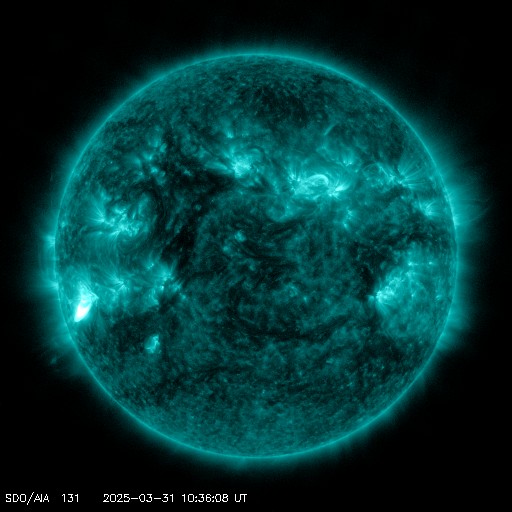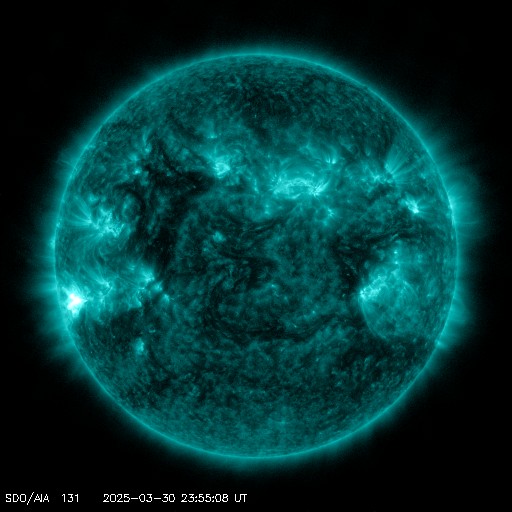Viewing archive of Thursday, 10 July 2003
Solar activity report
Any mentioned solar flare in this report has a scaling factor applied by the Space Weather Prediction Center (SWPC). Because of the SWPC scaling factor, solar flares are reported as 42% smaller than for the science quality data. The scaling factor has been removed from our archived solar flare data to reflect the true physical units.
Report of Solar-Geophysical Activity 2003 Jul 10 2200 UTCPrepared by the NOAA © SWPC and processed by SpaceWeatherLive.com
Joint USAF/NOAA Report of Solar and Geophysical Activity
SDF Number 191 Issued at 2200Z on 10 Jul 2003IA. Analysis of Solar Active Regions and Activity from 09-2100Z to 10-2100Z
Solar activity has been moderate. Region 397 (N12W87)
produced two M-class flares, an M2.0 at 09/2238Z, and an M3.6 at
10/1412Z with an associated Type II radio sweep. Region 397 appears
to be decaying as it passes the west limb. No new regions were
numbered today.
IB. Solar Activity Forecast
Solar activity is expected to be low
to moderate, with a chance of isolated M-class flares from Regions
397 or 400.
IIA. Geophysical Activity Summary 09-2100Z to 10-2100Z
The geomagnetic field has been at quiet to active levels. The
greater than 2 MeV electron fluxes at geosynchronous orbit reached
high levels.
IIB. Geophysical Activity Forecast
The geomagnetic field is
expected to be quiet to unsettled, with isolated active to minor
storm conditions on days one and two due to elevated solar wind
speeds as a coronal hole rotates into geoeffective position.
III. Event Probabilities 11 Jul to 13 Jul
| Class M | 50% | 45% | 40% |
| Class X | 10% | 05% | 05% |
| Proton | 05% | 05% | 05% |
| PCAF | green | ||
IV. Penticton 10.7 cm Flux
Observed 10 Jul 123 Predicted 11 Jul-13 Jul 130/125/120 90 Day Mean 10 Jul 124
V. Geomagnetic A Indices
Observed Afr/Ap 09 Jul 003/006 Estimated Afr/Ap 10 Jul 006/010 Predicted Afr/Ap 11 Jul-13 Jul 020/025-015/020-010/015
VI. Geomagnetic Activity Probabilities 11 Jul to 13 Jul
| A. Middle Latitudes | |||
|---|---|---|---|
| Active | 40% | 35% | 25% |
| Minor storm | 15% | 10% | 05% |
| Major-severe storm | 05% | 05% | 01% |
| B. High Latitudes | |||
|---|---|---|---|
| Active | 50% | 50% | 30% |
| Minor storm | 25% | 25% | 15% |
| Major-severe storm | 10% | 10% | 05% |
All times in UTC
Current data suggests there is a slight possibility for aurora to appear at the following high latitude regions in the near future
Whitehorse, YTAnchorage, AK, Fairbanks, AK, Juneau, AK, Utqiagvik, AK
Latest news
Latest forum messages
AR4046 136AR4048 35Solar Demon 3Unspecified geomagnetic activity 2146Aurora photography hints for those of us with smartphones 54
More topicsSupport SpaceWeatherLive.com!
A lot of people come to SpaceWeatherLive to follow the Sun's activity or if there is aurora to be seen, but with more traffic comes higher server costs. Consider a donation if you enjoy SpaceWeatherLive so we can keep the website online!

Latest alerts
11:15 UTC - Solar protons
Minor S1 Solar Radiation Storm - Minor impacts on HF radio through polar regions
10:45 UTC - Solar flare
Moderate M1.26 flare
10:27 UTC - Radio Blackout
Minor R1 radio blackout in progress (≥M1 - current: M1.22)
00:09 UTC - Solar flare
Moderate M1.03 flare
Sunday, 30 March 2025
23:51 UTC - Radio Blackout
Minor R1 radio blackout in progress (≥M1 - current: M1.03)
Space weather facts
| Last X-flare | 2025/03/28 | X1.1 |
| Last M-flare | 2025/03/30 | M1.0 |
| Last geomagnetic storm | 2025/03/27 | Kp5 (G1) |
| Spotless days | |
|---|---|
| Last spotless day | 2022/06/08 |
| Monthly mean Sunspot Number | |
|---|---|
| February 2025 | 154.6 +17.6 |
| March 2025 | 127 -27.6 |
| Last 30 days | 127 -25.7 |




